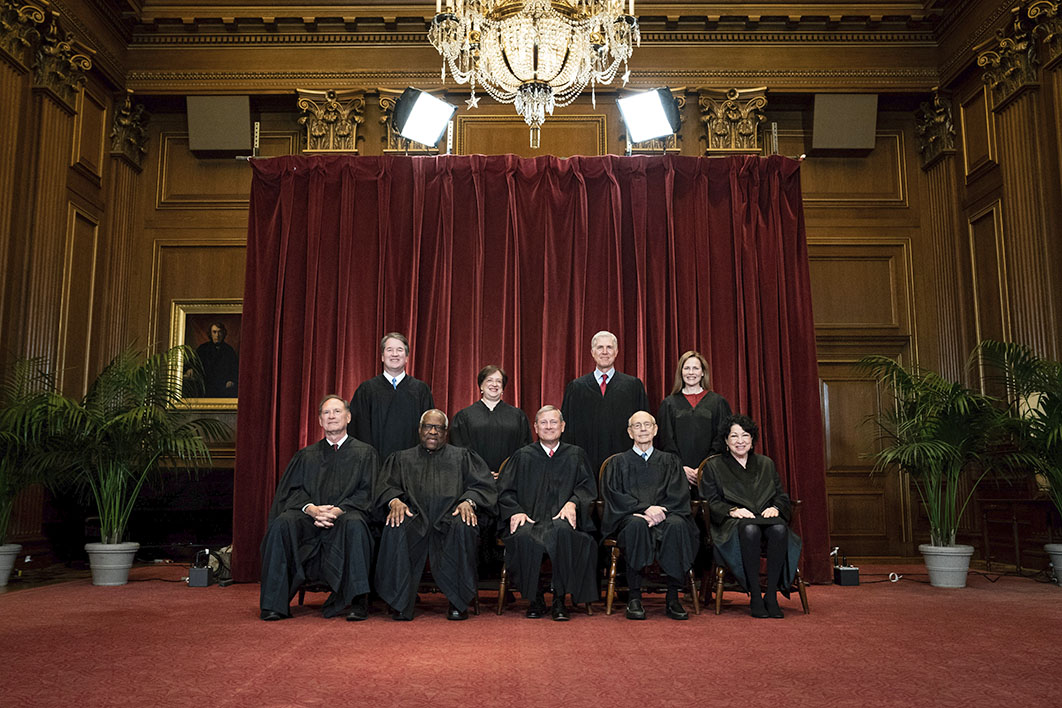Will the US Supreme Court overturn the landmark 1973 Roe v Wade ruling, which has underpinned legal access to abortion for almost half a century? This is a very real possibility following last month’s announcement that the court has agreed to rule on a restrictive Mississippi abortion law. The case will be heard in the American autumn (after 1 October) and the decision is not likely until the northern summer of 2022 — just as the midterm elections gather momentum.
The case the court has agreed to hear, Jackson Women’s Health Organization v Dobbs, challenges the constitutionality of a 2018 Mississippi law that bans almost all abortions after fifteen weeks of pregnancy, with narrow exceptions for medical emergencies or foetal abnormalities. A federal district judge and a panel of the US Court of Appeals for the Fifth Circuit have both upheld an appeal against the law launched by the women’s health organisation that runs the only abortion clinic in Mississippi.
The case effectively reopens both Roe v Wade and the US Supreme Court’s 1992 decision in Planned Parenthood v Casey, which held that “the state’s interests” in relation to a foetus that isn’t yet viable “are not strong enough to support a prohibition of abortion or substantial obstacle to the woman’s effective right to elect the procedure.” In accepting the Mississippi case, the court says it will examine whether “all pre-viability prohibitions on elective abortions are unconstitutional.” The state’s attorney-general will argue that the capacity to survive outside the womb is the wrong place to draw the line.
Among developed nations, the longstanding and increasingly partisan political battle over women’s reproductive rights is uniquely American. Continual challenges to legal guarantees encapsulated in Roe v Wade and elsewhere not only undermine women’s freedoms but are also likely to be contributing to the appalling rates of maternal and infant mortality in the world’s richest nation.
A quick history lesson highlights how precarious the legal right to abortion is for American women. While Roe v Wade is commonly seen as guaranteeing a right to abortion, it secures only the right to privacy when seeking access to an abortion, thus protecting a woman’s autonomy in the decision to have an abortion.
Even this is mitigated by what the distinguished legal journalist Linda Greenhouse calls “a physician-centric framework.” To a remarkable degree, indeed, Roe v Wade is about doctors’ rights. The majority opinion, written by Justice Harry Blackmun, actually says that “the attending physician, in consultation with his [sic] patient, is free to determine, without regulation by the State, that, in his medical judgment, the patient’s pregnancy should be terminated.” This doctor-knows-best rhetoric could well have helped enable the limitations since placed on American women’s reproductive rights.
It is important to note that Roe v Wade is essentially superseded by the 1992 decision. When this case reached the US Supreme Court, only Justice Blackmun remained of Roe’s seven-member majority, and a majority of the justices had been appointed by presidents who openly sought its reversal. Even so, the court surprised everyone by reaffirming Roe’s central tenet of the right to an abortion; but it also instituted an “undue burden” standard that permitted the state to regulate abortion to protect unborn life from the beginning of pregnancy, so long as women’s authority to decide whether to give birth was protected. In taking this approach, the court created opportunities for restrictions on abortion that Roe itself never sanctioned.
In the wake of the Roe v Wade decision, anti- and pro-abortion groups were galvanised. At the same time, Republican strategists were staking out anti-abortion positions as part of a strategy to appeal to Catholic and evangelical voters. This was the beginning of a growing partisan divide on the issue, which has become almost a litmus test for aspiring Republican lawmakers.
Efforts to limit abortion soon turned to focusing on funding for reproductive services. The Hyde amendment, introduced in 1976 and enacted by every Congress since, bans the use of federal Medicaid funds for abortion services, with exceptions for pregnancies resulting from rape or incest and pregnancies that would endanger the mother’s life. It is particularly harmful to women of colour and those with low incomes, who disproportionately rely on Medicaid for their healthcare coverage. (Note that the Hyde amendment does not block states from using their own Medicaid funds; currently fifteen states pay for more abortions than those permitted under the amendment.)
Gallup polls report that around 50 per cent of Americans agree abortion should be legal “under certain circumstances” and another 29 per cent “under all circumstances.” This level of public support makes the federal political fight difficult, leading anti-abortion activists to be more relentless in their use of the courts and to target Republican-dominated state legislatures.
Donald Trump oversaw a major effort to curtail abortion. The “gag rule” was applied to recipients of US global health aid (a hard line that was particularly punitive for female victims of sexual violence during conflicts), access to contraception was restricted, and insurers and healthcare professionals were given more latitude to deny reproductive health services. He also made good on his promise to load up the Supreme Court with justices who would overturn Roe v Wade by appointing Neil Gorsuch, Brett Kavanaugh and Amy Coney Barrett.
Joe Biden has been reticent about speaking out on abortion. His election campaign didn’t highlight the issue, and he hasn’t taken it up since moving into the Oval Office. Perhaps his Catholicism has played a role, but more likely his silence reflects the many other important issues that need to be tackled.
But he has made a good start on rolling back Trump’s undermining of women’s health. He has reversed the restrictions on funding Planned Parenthood and overseas groups that provide abortion referrals; reversed restrictions on the supply of medical abortion drugs; and removed hurdles to medical research that uses foetal tissue derived from abortions. He has appointed vocal advocates of abortion rights to key federal posts, including Xavier Becerra as health and human services secretary.
The mere fact that the Supreme Court agreed to take up this case indicates it is likely to overturn or severely limit the judicial basis of abortion rights. None of the usual criteria for accepting a case were satisfied — there was no split in the circuit decisions and no unsettled question of federal law — and the case had languished on the court’s docket since before the death of Justice Ruth Ginsburg, an ardent support of Roe v Wade. Moreover, the newer, more conservative justices have already shown their willingness to overturn longstanding precedents and expand the scope of decisions.
Biden will be under enormous pressure to do more to protect abortion rights, not just because of fears about the outcome of Jackson Women’s Health Organization v Dobbs but also because of even more draconian state-level anti-abortion provisions. Sixteen states have attempted to ban abortion before viability, mostly with “heartbeat” bills, which seek to ban the procedure from the time a foetal heartbeat can first be heard. (This is six weeks from conception, at which time many women are still unaware they are pregnant.)
The anti-abortion legislation recently passed by the Texas legislature highlights what the future could look like without Roe v Wade (which originated in Texas). It not only bans abortions after six weeks but also allows private citizens the right to sue anyone who aids or abets an abortion — including healthcare workers and facilities, insurance companies, counsellors, families, the person who drives the patient to the clinic, and even those who donate funds to support abortion services. As lawyers opposing the legislation have argued, it enables anti-abortion groups to “weaponise the judicial system” to paralyse women’s healthcare services, isolate women who need abortions, and intimidate these women’s supportive networks.
All of these bills have been blocked by court orders, and await the undoing of constraints imposed by Roe v Wade. Many more bills are coming: since January, 549 abortion restrictions, including 165 abortion bans, have been introduced across forty-seven states; sixty-nine of these, including nine bans, have been enacted.
Biden made an election commitment to codify Roe v Wade into federal law and abolish the long-time ban on federal funding for abortions via the Hyde amendment. Vice-president Kamala Harris campaigned on a proposal to create a “preclearance” system, analogous to that in the Voting Rights Act, whereby states that want to change abortion access must seek approval from the justice department. In a first step, Biden’s fiscal 2022 budget request, just released, omits the Hyde language.
To enact any or all of these provisions, Biden must determine how much pressure he wants to put on the Democrats in Congress to tackle these fraught issues ahead of the 2022 elections. And there is an additional problem: all of these measures can only be passed if the Senate filibuster (a requirement for sixty votes rather than a simple majority) is abolished.
A more contentious way to tackle this issue — one that is already on the table for some Democrats —is to expand the number of justices on the Supreme Court (there is precedent, although not recent). A group of Democrats has introduced a bill to do this in the House of Representatives; and, not surprisingly, Republicans have been scathing in their opposition. But the bill has a doubtful future even without Republican opposition: House speaker Nancy Pelosi has said she has no plans to bring it up for a vote.
Although the court’s composition is clearly on Biden’s mind, he has been in no hurry to make a decision. In April he signed an executive order setting up a bipartisan commission to examine the court’s size, the justices’ lifetime appointments and other court-related matters, thus fulfilling a campaign commitment.
The key issue that may drive Biden and his administration to apply more effort to abortion rights specifically and women’s reproductive health more generally is his strong commitment to improving access to healthcare and creating a more equitable society. “We are deeply committed to making sure everyone has access to care — including reproductive health care — regardless of income, race, zip code, health insurance status, or immigration status,” Biden said in a joint statement with Harris on the forty-eighth anniversary of Roe v Wade in January.
The hard line against abortion rights that is so prevalent in American politics puts women’s lives, livelihoods and health at risk and widens the disparities between rich and poor that are already a feature of US healthcare. More importantly, the current battles ignore the real-life complexity — ethical and financial — of ending a pregnancy. That is not likely to change any time soon. •




